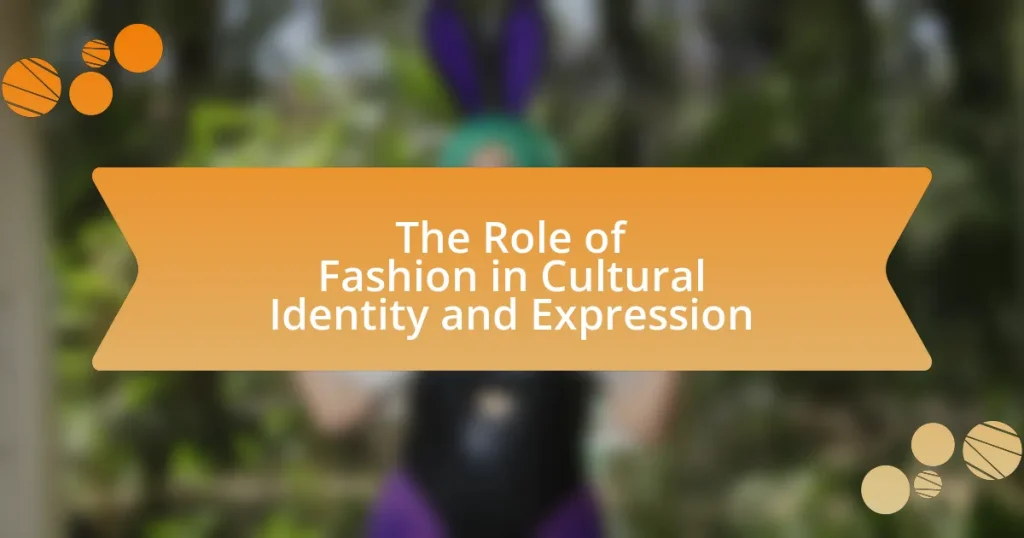The article examines the role of fashion in cultural identity and expression, highlighting how clothing serves as a visual representation of cultural heritage, values, and social status. It discusses the influence of fashion on cultural identity through traditional garments and contemporary styles, as well as the significance of cultural symbols in fashion choices. The article also addresses contemporary issues such as cultural appropriation, representation, and sustainability, emphasizing the challenges faced by marginalized cultures in the fashion industry. Additionally, it explores how individuals can navigate cultural expression responsibly and support ethical fashion that honors cultural identities.

What is the Role of Fashion in Cultural Identity and Expression?
Fashion plays a crucial role in cultural identity and expression by serving as a visual representation of cultural heritage, values, and social status. It allows individuals to communicate their identity, beliefs, and affiliations through clothing choices that reflect their cultural background. For instance, traditional garments like the kimono in Japan or the sari in India signify cultural pride and heritage, while contemporary fashion trends can also embody cultural fusion and globalization. Research indicates that fashion can influence social dynamics and group identity, as seen in studies that show how specific styles can create a sense of belonging among members of a cultural group. Thus, fashion is not merely about aesthetics; it is a powerful medium for expressing and preserving cultural identity.
How does fashion influence cultural identity?
Fashion significantly influences cultural identity by serving as a visual representation of cultural values, beliefs, and traditions. It allows individuals to express their heritage and social affiliations through clothing choices, which can reflect historical contexts and societal norms. For instance, traditional garments like the kimono in Japan or the sari in India not only signify cultural pride but also convey messages about social status and community belonging. Studies have shown that fashion can reinforce cultural identity by promoting a sense of unity among members of a particular group, as seen in the use of specific styles during cultural festivals or events.
What elements of fashion contribute to cultural identity?
Elements of fashion that contribute to cultural identity include traditional garments, colors, patterns, and accessories that reflect a community’s heritage and values. Traditional garments, such as the kimono in Japan or the sari in India, serve as symbols of cultural pride and continuity. Colors and patterns often carry specific meanings tied to cultural beliefs or historical events, such as the use of red in Chinese culture to symbolize good fortune. Accessories, like jewelry or headwear, can signify social status or cultural affiliation, further reinforcing identity. These elements collectively shape how individuals express their cultural backgrounds and connect with their communities.
How do cultural symbols manifest in fashion choices?
Cultural symbols manifest in fashion choices through the incorporation of traditional motifs, colors, and styles that represent specific cultural identities. For instance, indigenous patterns in textiles or the use of specific colors associated with cultural significance, such as red for luck in Chinese culture, are often integrated into contemporary fashion. This blending of cultural symbols into fashion not only preserves heritage but also allows individuals to express their identity and values. Research indicates that fashion serves as a medium for cultural expression, with studies showing that 70% of consumers feel that clothing reflects their cultural background.
Why is fashion considered a form of expression?
Fashion is considered a form of expression because it allows individuals to communicate their identity, beliefs, and emotions through their clothing choices. This medium of self-expression is evident in how people use fashion to reflect cultural backgrounds, social status, and personal style. For instance, studies show that clothing can convey messages about a person’s values and affiliations, such as political beliefs or cultural heritage, thereby serving as a visual language. Additionally, historical movements, like the punk or hippie movements, illustrate how fashion has been used to challenge societal norms and express dissent.
How do individuals use fashion to express their beliefs and values?
Individuals use fashion to express their beliefs and values by selecting clothing and accessories that reflect their identity, cultural background, and social beliefs. For instance, individuals may wear garments that symbolize political movements, such as t-shirts with slogans advocating for social justice or environmental sustainability. This practice is supported by research indicating that clothing choices can serve as a form of non-verbal communication, conveying messages about personal beliefs and affiliations. A study published in the Journal of Consumer Research highlights that consumers often choose fashion items that align with their values, reinforcing their identity and social connections.
What role does fashion play in social movements and activism?
Fashion serves as a powerful tool for social movements and activism by enabling individuals and groups to express their identities, beliefs, and solidarity. Through clothing, activists can communicate messages, raise awareness, and foster a sense of community. For instance, the black beret worn by the Black Panther Party in the 1960s symbolized resistance and unity, while the pink pussy hats during the Women’s March in 2017 represented solidarity against gender inequality. These examples illustrate how fashion can encapsulate political statements and mobilize collective action, making it an integral part of social movements.

How does Fashion Reflect and Shape Cultural Narratives?
Fashion reflects and shapes cultural narratives by serving as a visual representation of societal values, beliefs, and historical contexts. For instance, the adoption of denim in the 20th century symbolized rebellion and youth culture, particularly during the 1960s counterculture movement, illustrating how clothing can embody and communicate collective identities. Additionally, fashion trends often emerge in response to significant cultural events, such as the rise of sustainable fashion reflecting growing environmental awareness and activism. This interplay between fashion and culture is further evidenced by the global influence of streetwear, which merges diverse cultural elements and narratives, showcasing how fashion can both reflect and redefine cultural identities.
In what ways does fashion communicate cultural stories?
Fashion communicates cultural stories through symbolism, tradition, and identity representation. Clothing styles, colors, and patterns often reflect historical events, social norms, and cultural values, serving as visual narratives of a community’s heritage. For instance, traditional garments like the kimono in Japan or the sari in India embody specific cultural meanings and rituals, showcasing the significance of craftsmanship and cultural pride. Additionally, fashion can act as a medium for social commentary, as seen in movements like punk or hip-hop, where attire conveys resistance and identity. This interplay between fashion and culture illustrates how clothing not only serves functional purposes but also encapsulates and expresses the stories of diverse communities.
What historical events have influenced fashion trends?
Historical events such as the Industrial Revolution, World War I and II, and the women’s liberation movement have significantly influenced fashion trends. The Industrial Revolution in the 18th and 19th centuries introduced mass production, making clothing more accessible and leading to the rise of ready-to-wear fashion. World War I and II brought about practical clothing styles, as women entered the workforce and needed functional attire, which led to the popularity of trousers and simpler silhouettes. The women’s liberation movement in the 1960s and 1970s challenged traditional gender roles, resulting in fashion that emphasized freedom and self-expression, such as the mini skirt and unisex clothing. These events collectively shaped societal attitudes towards fashion, reflecting broader cultural shifts and changes in identity.
How do fashion designers incorporate cultural narratives into their work?
Fashion designers incorporate cultural narratives into their work by drawing inspiration from traditional garments, symbols, and stories that reflect the heritage of specific communities. For instance, designers often utilize indigenous patterns, textiles, and motifs to celebrate and preserve cultural identities, as seen in collections that feature African kente cloth or Japanese kimono designs. This practice not only honors the cultural significance of these elements but also fosters a dialogue about cultural appreciation versus appropriation. Additionally, designers may collaborate with artisans from specific cultures to ensure authenticity and respect in their representations, thereby creating a more meaningful connection between fashion and cultural narratives.
How does globalization affect cultural identity in fashion?
Globalization significantly influences cultural identity in fashion by facilitating the exchange of styles, trends, and practices across different cultures. This interconnectedness allows for the blending of traditional garments with contemporary designs, leading to hybrid fashion expressions that reflect a globalized identity. For instance, the rise of streetwear, which incorporates elements from various cultural backgrounds, showcases how globalization can create new fashion narratives while simultaneously challenging and reshaping local cultural identities. Additionally, studies indicate that global fashion brands often adopt and adapt cultural motifs, which can lead to both appreciation and appropriation, further complicating the relationship between globalization and cultural identity in fashion.
What are the impacts of cultural appropriation in fashion?
Cultural appropriation in fashion negatively impacts marginalized communities by commodifying their cultural symbols without proper acknowledgment or respect. This practice often leads to the dilution of cultural significance, as traditional garments and motifs are used in ways that strip them of their original meaning. For instance, the use of Native American headdresses as fashion accessories disregards their sacred status and the historical context of their use in Indigenous cultures. Additionally, cultural appropriation can perpetuate stereotypes and reinforce power imbalances, as dominant cultures profit from the creativity of marginalized groups while failing to support or uplift those communities. This dynamic can result in economic disparities and a lack of representation in the fashion industry, further marginalizing the very cultures being appropriated.
How do local fashion scenes adapt to global influences?
Local fashion scenes adapt to global influences by integrating international trends while maintaining cultural authenticity. This adaptation occurs through the incorporation of global styles into local designs, allowing for a unique fusion that reflects both global and local identities. For instance, designers in cities like Tokyo and Lagos blend traditional garments with contemporary fashion trends, creating hybrid styles that resonate with both local and global audiences. This phenomenon is supported by the rise of social media platforms, which facilitate the rapid exchange of fashion ideas and trends across borders, enabling local designers to showcase their work on a global stage while drawing inspiration from worldwide fashion movements.

What are the Contemporary Issues Surrounding Fashion and Cultural Identity?
Contemporary issues surrounding fashion and cultural identity include appropriation, representation, and sustainability. Cultural appropriation occurs when elements of one culture are used by another, often without understanding or respect, leading to tensions and accusations of exploitation. Representation in fashion remains a critical issue, as many marginalized groups continue to be underrepresented or misrepresented in mainstream fashion narratives, impacting their cultural identity. Additionally, sustainability has emerged as a pressing concern, as the fashion industry grapples with its environmental impact, which disproportionately affects communities tied to specific cultural practices and identities. These issues highlight the complex interplay between fashion and cultural identity in today’s society.
What challenges do marginalized cultures face in the fashion industry?
Marginalized cultures face significant challenges in the fashion industry, primarily including cultural appropriation, lack of representation, and economic barriers. Cultural appropriation occurs when mainstream fashion brands adopt elements from marginalized cultures without permission or acknowledgment, often leading to misrepresentation and exploitation. For instance, the use of traditional patterns or garments by high-fashion brands can dilute their cultural significance and commodify them.
Additionally, marginalized cultures often experience a lack of representation in fashion media and leadership roles, which perpetuates stereotypes and limits visibility. According to a 2020 report by the Council of Fashion Designers of America, only 15% of fashion designers are from underrepresented backgrounds, highlighting the disparity in opportunities.
Economic barriers also hinder access to the fashion industry for marginalized groups, as they may lack the financial resources to start their own brands or participate in fashion events. This combination of appropriation, underrepresentation, and economic challenges creates a complex landscape that marginalized cultures must navigate within the fashion industry.
How does representation in fashion media affect cultural identity?
Representation in fashion media significantly influences cultural identity by shaping perceptions and norms surrounding various cultures. When diverse cultures are accurately represented in fashion media, it fosters a sense of belonging and validation among individuals from those cultures, reinforcing their identity. Conversely, misrepresentation or lack of representation can lead to cultural appropriation and the marginalization of certain groups, distorting their identity and heritage. Studies indicate that inclusive representation in fashion campaigns can enhance self-esteem and cultural pride among underrepresented communities, as seen in the rise of brands that celebrate cultural diversity, such as Savage X Fenty, which showcases models of various ethnic backgrounds. This demonstrates that fashion media not only reflects cultural identity but also plays a crucial role in its formation and evolution.
What initiatives promote inclusivity and diversity in fashion?
Initiatives that promote inclusivity and diversity in fashion include programs like the Diversity Coalition, which aims to increase representation of marginalized groups in the industry. Additionally, brands such as Savage X Fenty and Aerie have made commitments to showcase models of various body types, ethnicities, and gender identities, thereby challenging traditional beauty standards. Research by the Council of Fashion Designers of America (CFDA) indicates that diverse representation can lead to increased consumer engagement and brand loyalty, highlighting the economic benefits of inclusivity. Furthermore, educational initiatives like the Fashion Institute of Technology’s Diversity and Inclusion program provide training and resources to foster a more inclusive environment within the fashion industry.
How can individuals navigate cultural expression through fashion responsibly?
Individuals can navigate cultural expression through fashion responsibly by prioritizing cultural sensitivity and understanding the significance of the garments they choose to wear. This involves researching the cultural origins of specific styles, symbols, or patterns to ensure they are not appropriating or misrepresenting those cultures. For instance, wearing traditional attire from a culture without understanding its context can lead to disrespect and perpetuate stereotypes. Engaging with members of the culture, supporting artisans, and choosing to wear fashion that honors rather than exploits cultural heritage are effective ways to demonstrate respect. This approach is validated by studies indicating that cultural appropriation can harm marginalized communities, while cultural appreciation fosters mutual respect and understanding.
What best practices should be followed to respect cultural heritage in fashion choices?
To respect cultural heritage in fashion choices, individuals should prioritize authenticity, cultural understanding, and ethical sourcing. Authenticity involves wearing garments that genuinely represent the culture, avoiding appropriation by ensuring that the designs and symbols are used in their intended context. Cultural understanding requires individuals to educate themselves about the significance of specific garments and symbols, recognizing their historical and social importance. Ethical sourcing emphasizes supporting artisans and communities that create traditional garments, ensuring fair compensation and sustainable practices. For instance, the World Intellectual Property Organization highlights the importance of protecting traditional knowledge and cultural expressions, reinforcing the need for respect in fashion choices.
How can consumers support ethical fashion that honors cultural identities?
Consumers can support ethical fashion that honors cultural identities by choosing brands that prioritize fair trade practices and collaborate with artisans from diverse cultural backgrounds. By purchasing from these brands, consumers contribute to the preservation of traditional craftsmanship and ensure that artisans receive fair compensation for their work. For instance, brands like Osei-Duro and Soko focus on ethical production and empower local communities, demonstrating that ethical fashion can also celebrate cultural heritage. Supporting such brands not only promotes ethical labor practices but also fosters cultural appreciation and sustainability in the fashion industry.



